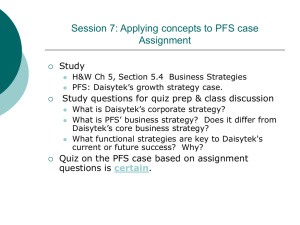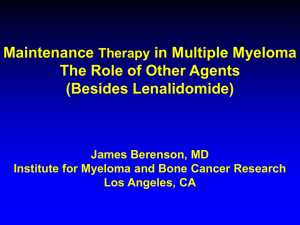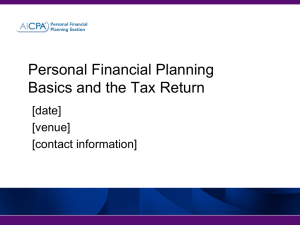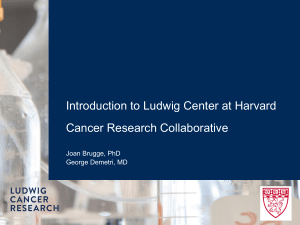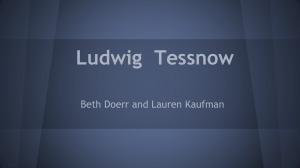Heinz Ludwig - UK Myeloma Forum
advertisement
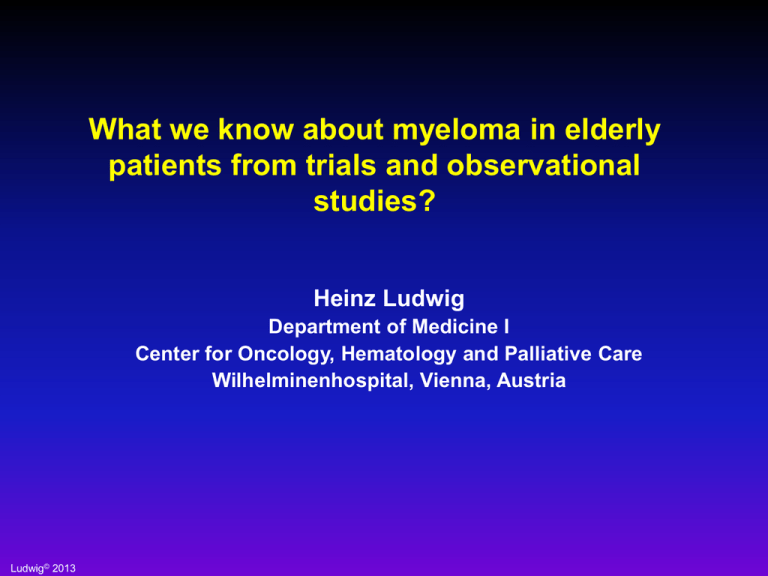
What we know about myeloma in elderly patients from trials and observational studies? Heinz Ludwig Department of Medicine I Center for Oncology, Hematology and Palliative Care Wilhelminenhospital, Vienna, Austria Ludwig© 2013 Goals of therapy in elderly patients Rapid symptom control Optimal quality of life Few and acceptable side effects Best possible quality of response Long PFS Long OS Cure ? Ludwig© 2013 Drug combinations for elderly patients Possible options 1-drug* 2 - drugs 3- drugs 4 - drugs Dex Bendamustine +P MPT VMPT Thal VD VMP MP* CTD Thal-Dex VTD L-ldDex *only exceptional cases Most commonly used combinations contain 2-3 drugs Ludwig© 2013 Characteristics of the Elderly Patient Chronological age does not necessarily correlate with biological age All three individuals are 70 years old Fit Minor morbidity significant morbidity The variation in biological fitness in a specific age cohort increases with rising age, but the ‚biology‘ of myeloma cells does not vary with age H. Ludwig 2013 Treatment of patients with multiple myeloma not eligible for transplantation Assess fraility Fit Unfit Full go Slow go Very slow go reduce dose 2 (3) drug regimen further dose reduction MP, CTX-P VD, Ld 2 or 3 drug regimen Ludwig© 2013 Frail Instruments for assessing fraility and allocation to treatment groups Assess Age ADL IADL Charlson comorbidity score Fit Unfit Frail Age <80 yr Fit >80 yr Unfit >80 yr ADL 6 ADL 5 ADL ≤4 IADL 8 IADL 6-7 IADL ≤5 Charlson 0 Charlson 1 Charlson ≥2 Go-go Moderate-go Slow-go Full-dose Reduced-dose Reduced-dose regimens regimens Palliative Dose level 0 Dose level -1 approach Dose level -2 Palumbo A et al. IMW 2013 H. Ludwig 2013 Adaptation of dose according to risk factors Agent Dose level 0 Dose level-1 Dose level - 2 Dexamethasone 40 mg 20 mg 10 mg Melphalan 0.25 mg/kg or 9 mg/m2 0.18 mg/kg or 7.5 mg/m2 0.13 mg/kg or 5 mg/m2 Thalidomide 100 mg 50 mg 50 mg/qod Lenalidomide 25 mg 15 mg 10 mg Bortezomib 1.3 mg twice weekly, sc 1.3 mg weekly, sc 1.0 mg weekly, sc Prednisone 60 mg/m2 30 mg/m2 15 mg/m2 Cyclophosphamide 100 mg 50 mg 50 mg/qod Palumbo et al.,BLOOD 2011 H. Ludwig 2013 Comorbidities relevant for treatment selection in myeloma Polyneuropathy Avoid bortezomib (or use once weekly sc) Renal impairment Consider dose adaptations when using lenalidomide Bone marrow insufficiency Careful dosing of cytoreductive drugs, consider single agent dexamethasone Cardiac arrhythmias/ dysfunction Cave: Thalidomide & high dose dexamethasone Immune system Careful dosing of cytoreductive drugs Diabetes Cave: high dose dexamethasone Cognitive function/ compliance Consider iv regimens H. Ludwig 2013 Higher risk of mortality in patients ≥ 75 years of age Retrospective meta-analysis of 4 EU phase III trials (N = 1,435) with MP, MPT, VMP, and VMPT • Median follow up 33 months • Median OS in total population 50 months • Estimated 3-year OS 68% in patients < 75 years of age vs 57% in patients ≥ 75 years of age (HR 1.44, CI 1.20-1.72, p < 0.001) HR (95% CI) p value All 1.44 (1.20–0.72) < 0.001 MP 1.21 (0.90–1.64) 0.21 MPT 1.12 (0.81–1.56) 0.49 VMP 1.62 (1.04–2.52) 0.03 VTP/VMPT 3.02 (1.86–4.90) < 0.001 0.1 Higher mortality in patients < 75 years of age H. Ludwig 2013 1 10 Higher mortality in patients ≥ 75 years of age Bringhen S, et al. Haematologica. 2013;98:980-7. Age and Organ Damage Correlate with Poor OS: Meta-analysis of 4 Randomized Trials • n=1435 (≥ 65 yrs ): MPT vs MP, VMP vs MP, VMP vs VMPT-VT Ludwig© 2013 Bringhen et al. Haematologica 2013;98(6):980-987 Phase III studies incorporating novel agents in the non-transplant setting New Regimen Comparator Outcome MPT (6 Trials)* vs. MP MPT PFS 5/6, OS 2/6 CTDa vs. MP CTDa ORR VMP vs. MP VMP PFS, OS VMPT VT vs. VMP VMPT VT PFS. OS VDT VT or VP ns VMP VT or VP MPR R vs. MPR or MP MPR R PFS LD vs. Ld Ld PFS, OS LD continous vs. Ld x 18, vs MPT x 12 Ld cont PFS, OS *Meta-analysis of the 6 trials: H. Ludwig 2013 PFS () OS MPT vs MP: Meta-analysis of 1685 individual-patient data of 6 randomized trials OS PFS Median 39.3 mos 0.8 0.8 MPT MP 1.0 HR=0.83 in favor of MPT, p=0.005* (35.6-44.6) Median 32.7 mos 0.4 0.4 (18.8-21.6) (30.5-36.6) 0.2 Median 14.9 mos 0.2 MPT MP 0.6 0.6 Median 20.3 mos (14.0-16.6) 0.0 0.0 Survival proportion 1.0 HR=0.67 in favor of MPT, p<0.0001 0 12 24 months 36 48 0 12 24 36 48 months *Cox model for treatment, with analysis stratified by study using a random effects (frailty) model Fayers et al. Blood 2011, accepted for publication 30 May 2011 H. Ludwig 2013 MPT: Pros and Cons Pros Cons Survival benefit Thalidomide toxicity Oral regimen Suboptimal in cytogenetic high risk Not expensive group Shorter survival after relapse H. Ludwig 2013 MP vs. VMP (VISTA) Final updated OS analysis Median follow-up 60.1 months •31% reduced risk of death 100 90 Median OS benefit: 13.3 months 5-year OS rates: 46.0% vs 34.4% Patients alive (%) 80 70 60 50 40 30 Group N M 338 VMP 344 20 10 Event 211 176 Median 43.1 56.4 HR (95% CI) P-value 0.695 (0.567, 0.852) 0.0004 0 0 H. Ludwig 2013 6 12 18 24 30 36 42 Time (months) 48 54 60 66 72 78 San Miguel et al. JCO 2013 Overall survival in different subgroups: VMP vs. MP H. Ludwig 2013 San Miguel et al., JCO 2013 VMP induced CR is associated with improved outcome Time to progression Treatment-free interval Time to next therapy Overall survival Harousseau JL et al., BLOOD 2010 H. Ludwig 2013 VD vs. VTD vs. VMP followed by bortezomib maintenance therapy Parameter VD VTD VMP >VGPR 36% 44% 40% ORR 68% 78% 71% PNP G3-4 15% 26% 20% PFS (mos) 13.8 18.4 17.3 H. Ludwig 2013 Niesvitzky R. et al., BLOO, 116 2010 Global QoL during VD, VTD and VMP induction therapy VD vs. VTD or VMP: shorter PFS, similar OS, better tolerance H. Ludwig 2013 Niesvizky R et al., ASH 2011 Treatment schedule Treatment schedule 511 patients (older than 65 years) randomized from 58 Italian centers Patients: Symptomatic multiple myeloma/end organ damage with measurable disease ≥65 yrs or <65 yrs and not transplant-eligible; creatinine ≤ 2.5 mg/dL R A N D O M I Z E VMP Cycles 1-9 Bortezomib 1.3 mg/m2 IV: days 1,8,15,22* Melphalan 9 mg/m2 and prednisone 60 mg/m2 days 1-4 9 x 5-week cycles in both arms VMPT Cycles 1-9 Bortezomib 1.3 mg/m2 IV: days 1,8,15,22* Melphalan 9 mg/m2 and prednisone 60 mg/m2 days 1-4 Thalidomide 50 mg/day continuously NO MAINTENANCE Until relapse MAINTENANCE Bortezomib 1.3 mg/m2 IV: days 1,15 Thalidomide 50 mg/day continuously * 66 VMP patients and 73 VMPT patients were treated with twice weekly infusions of Bortezomib H. Ludwig 2013 PFS and OS: VMP vs VMPT –VT Progression free survival landmark analysis Overall survival Palumbo A et al. ASH 2012 H. Ludwig 2013 Overall survival Overall survival, Landmark analysis Landmark analysis Age < 75 years 1.00 ISS 1-2 1.00 0.75 0.75 0.75 0.50 0.50 0.50 0.25 0.25 0.25 HR 0.60, 95% CI, 0.41-0.89, p=0.009 HR 0.66, 95% CI, 0.43-1.00, p =.05 0.00 HR 0.45, 95% CI, 0.24-0.86, p =.01 0.00 0.00 0 10 20 30 40 50 60 70 Age ≥ 75 years 1.00 0 10 20 30 40 50 60 0 70 ISS 3 1.00 0.75 0.75 0.50 0.50 0.50 0.25 0.25 0.25 HR 0.76, 95% CI, 0.42-1.37, p =.36 10 20 VMPT VT maint. VMP No maint. H. Ludwig 2013 30 40 50 Off therapy 60 70 20 30 40 50 60 70 VGPR/PR HR 0.80, 95% CI, 0.54-1.20, p =.28 HR 0.64, 95% CI, 0.31-1.31, p =.22 0.00 0 10 1.00 0.75 0.00 CR 1.00 0.00 0 10 20 VMPT VT maint. VMP No maint. 30 40 50 Off therapy 60 70 0 10 20 VMPT VT maint. VMP No maint. 30 40 50 Off therapy 60 70 Overall survival from relapse Overall survival from relapse 1.00 3-years OS VMPT-VT Median OS 47% 27.8 months 46% 27.3 months 0.75 Patients (%) VMP 0.50 0.25 HR 0.92, 95% CI, 0.66-1.28, p =.63 0.00 0 10 20 30 40 50 60 Time (months) H. Ludwig 2013 Palumbo et al. ASH 2012 (Abstract 200) VMPT-VT versus VMP in newly diagnosed elderly patients • Significant OS benefit in patients – < 75 years of age (none in pts > 75 years) – With stage ISS 1-2 (tendency for OS in stage ISS 3) – With CR (none in pts with VGPR/PR) • Benefit in ‚good risk‘ patients with CR only • Grade 3- 4 adverse events during VT maintenance – PN 7% – Hematological toxicity 5% – Infection 3% – Discontinuation due to AEs 12% H. Ludwig 2013 Palumbo et al. ASH 2012 (Abstract 200), oral presentation How to reduce toxicity of Bortezomib and and maintain efficacy? H. Ludwig 2013 Bortezomib once weekly longer duration of therapy similar cumulative dose similar efficacy less toxicty (G3/4 neurotoxicity) Bortezomib subcutaneously 10 times lower serum peak concentration similar area under the curve less neurotoxicity similar efficacy - MPR-R vs. MPR vs. MP (MM015 trial) N = 459, 82 centers in Europe, Australia, and Israel Open-Label Extension Phase Double-blind Treatment Phase Cycles (28-day) 1-9 RANDOMIZATION MPR-R M: 0.18 mg/kg, days 1-4 P: 2 mg/kg, days 1-4 R: 10 mg/day po, days 1-21 Cycles 10+ Maintenance Lenalidomide 10 mg/day days 1-21 MPR M: 0.18 mg/kg, days 1-4 P: 2 mg/kg, days 1-4 R: 10 mg/day po, days 1-21 Placebo MP M: 0.18 mg/kg, days 1-4 P: 2 mg/kg, days 1-4 PBO: days 1-21 • • Disease Progression Lenalidomide (25 mg/day) +/Dexamethasone Placebo Stratified by age (<75 years vs > 75 years) and stage (ISS I/II vs III) ISS, International Staging System; MP, melphalan, prednisone; MPR,melphalan, prednisone,lenalidomide ; MPR-R, melphalan, prednisone,lenalidomidewith lenalidomidemaintenance; PBO, placebo. H. Ludwig 2013 - Progression-Free andand Overall Survival Progression-free overall survival All Patients Median PFS 100 4-year OS MPR-R 31 months MPR-R 59% MPR 14 months MPR 58% MP 13 months MP 58% 100 HR 0.898 75 HR 0.395 50 P < .001 HR 0.796 25 P = .135 0 0 10 20 Time (Months) 30 40 Patients (%) Patients (%) 75 P = .579 50 HR 1.089 P = .648 25 0 0 10 20 30 40 Time (Months) • TTP HR advantages were similar: MPR-R vs MP = 0.337; MPR vs MP = 0.826 HR, hazard ratio; MP,melphalan, prednisone; MPR,melphalan, prednisone,lenalidomide ; MPR -R, melphalan, prednisone, lenalidomidewith lenalidomidemaintenance; OS, overall survival; PFS, progression free survival; TTP, time to progression. H. Ludwig 2013 50 60 PFS and OS With R and MPR PFS and OS MPR with -MPR-R and MPR Patients Aged 65-75 Years patients aged 65-75 years Median PFS 100 4-Year OS MPR-R 31 months MPR-R 69% MPR 15 months MPR 61% MP 12 months MP 58% 100 Patients (%) 75 HR 0.301 P < .001 50 HR 0.618 P = .006 Patients (%) HR 0.706 HR 0.902 25 0 0 10 20 Time (Months) 30 40 P = .639 50 25 0 P = .133 75 0 10 20 30 40 Time (Months) HR, hazard ratio; MP, melphalan, prednisone; MPR, melphalan, prednisone, lenalidomide; MPR-R, melphalan, prednisone, lenalidomide with lenalidomide maintenance; OS, overall survival; PFS, progression-free survival. H. Ludwig 2013 50 60 FIRST: Phase 3 trial of Lenalidomide + low-dose Dex vs MPT (IFM 07-01; MM-020) Centres in EU, Switzerland, APAC, USA, and Canada Inclusion criteria N = 1,623 • Previously untreated MM • Age 65 years or not eligible for a transplant • No neuropathy of grade > 2 Primary end-point: PFS R A N D O M I Z A T I O N Rd (28-day cycle; until disease progression) Lenalidomide 25 mg/day, days 1–21 Dexamethasone* 40 mg/day, days 1, 8, 15, and 22 Rd (28-day cycle; up to 18 cycles) Lenalidomide 25 mg/day, days 1–21 Dexamethasone* 40 mg/day, days 1, 8, 15, and 22 MPT (6-week cycle; up to 12 cycles ) Melphalan* 0.25 mg/kg/day, days 1–4 Prednisone 2.0 mg/kg/day, days 1–4 Thalidomide* 200 mg/day *In patients aged > 75 years: Dex 20 mg/day, melphalan 0.20 mg/kg/day, thalidomide 100 mg/day H. Ludwig 2013 NCT00689936. Available from: www.clinicaltrials.gov. What is the optimal duration of first line therapy? Trials & duration of therapy (months) VMP (Vista) 12 MPT trials 6-18.5 CTDa 6-9 MPR-R 9, R untill PD VMPT-VT 12.5, VT maintenance: 2 years LD (MM20) Continously until PD/intolerance Duration of therapy: minimally 6, maximally 12 months Most experts recommend ≈ 9 months H. Ludwig 2013 Outcome with novel combinations CR rate (%) Median PFS (months) Median OS (months) rare 11–20 29 - 43.45 - 49.42 - 14* 32 MPT3 10 20.3 39 CTDa4 13 13 33 VMP5 30 21.7–27.4 56.4 MPR-R6 10 31 59% (4-yr OS) VMP-VT/VP7 42 35 58% (5-yr OS) VMPT-VT8,9 42 35.3 59.3% (5-yr OS) ≥PR 75% vs. 62% 28% ↓ risk for PD 22% ↓ risk for death MP1,2 BP2 LD continuous10 1MTCG. J Clin Oncol 1998;16(12):3832-42 2Ludwig et al., BLOOD 2009 2Pönisch et al. J Cancer Res Clin Oncol. 2006;132:205-12. 3Fayers et al. Blood 2011; 118(5):1239-1247 4Morgan et al. Blood 2011;118:1231-8 H. Ludwig 2013 5San Miguel et al. JCO 2013; 31(4): 448-455 et al. N Engl J Med 2012;366(19):1759-69 7Mateos et al. Blood 2012; 120: 2581-2588 8Palumbo et al. ASH 2012 (Abstract 200), oral presentation 9Palumbo et al. ASH 2011 (Abstract 653), oral presentation 10Facon et al. ASH 2013 (Abstract 2), oral presentation 6Palumbo Hematologic CR correlates with long PFS and OS in elderly patients treated with novel agents • Retrospective analysis: 3 randomized European trials of GIMEMA and HOVON groups (N=1175) • First-line treatment MP (n=332), MPT (n=332), VMP (n=257), VMPT-VT (n=254) OS PFS CR VGPR P<0.001 PR VGPR Probability Probability CR PR P<0.001 Significant benefit also seen when analysis is restricted to patients >75 years old H. Ludwig 2013 Gay et al. Blood 2011; 117(11):3025-31 Immunophenotypc CR correlates with OS GEM2005 >65y 100 PFS 80 60 40 Immunophenotypic CR 90% at 3y “Stringent CR” 38% at 3y Conventional CR 57% at 3y PR (≥70% reduction) 28% at 3y 20 Paiva et al; J Clin Oncol. 2011;29(12):1627-33. H. Ludwig 2013 Cytogenetic abnormalities are a major prognostic factor in elderly patients with MM: IFM experience 1,890 patients (median age 72, range 66–94), including 1,095 patients with updated data on treatment modalities and survival OS according to t(4:14) 1.00 OS according to del(17p) 1.00 p < 10.6 0.75 Probability of OS Probability of OS p < 10.4 0.50 0.25 0.75 0.50 0.25 t(4:14) neg t(4:14) pos del(17p) < 60 del(17p) ≥ 60 0.00 0.00 0 1 2 3 Time (years) 4 5 0 1 2 3 Time (years) 4 5 Whatever the treatment, t(4;14) and del(17p) were associated with shorter PFS and OS; similar results were achieved in the subgroup of 335 patients > 75 years H. Ludwig 2013 1. Avet-Loiseau H, et al. J Clin Oncol. 2013 31(22):2806-9. 2. Hulin et al. Blood 2012:[abstract 204]. The challenge of high-risk CA [t(4;14), del(17p), t(14;16)] in NDMM elderly patients Study MPT/MP1 No of pts with high-risk CA Outcome of high-risk CA patients NR NR CTDa/MP1 (MRC Myeloma IX) NR CTDa does not overcome the effect of high-risk CA and is not significantly better than MP in high-risk CA RD/Rd2 (E4A03) 21 2y OS=76% for high-risk CA vs 91% VMP/MP3 (VISTA) 46 Absence of OS benefit, median OS 44.1mo. VMP vs 50.6 mo., MP 44 Adverse prognosis of both t(4;14) and del (17p) regardless of induction and maintenance. Median OS t(4;14)=29 mo., del(17p) = 27mo. VMP/VTP – VT/VP4 (GEM-05) First generation novel agents only partly overcome the negative prognosis of high-risk CA in newly diagnosed elderly patients with MM H. Ludwig 2013 1. Bergsagel PL, et al. Blood. 2013;121:884-91. 2. Rajkumar SV, et al. Lancet Oncol. 2010;11:29-37. 3. San Miguel J, et al. J Clin Oncol. 2013;31:448-55. 4. Mateos MV, et al. Blood. 2011;118:4547-53. Maintenance studies - summary Thalidomide PFS no improvement in OS Reduced OS after relapse Negative impact on high risk pts Clinical practice recommendations 50 mg for ≈ 12 mos may be considered Lenalidomide Bortezomib-thalidomide H. Ludwig 2013 PFS -no improvement in OS -increased risk for SPM Tendency for PFS and OS but not significant superior over VP Summary: Treatment results in elderly patients MPT, PFS, +/- OS, can be toxic in elderly pts VMP, PFS OS, may induce severe PNP Ld, PFS, OS, low dose Dex recommended Thal-Dex, an option for fit pts CTDa vs MP, overall response rate, CR, VGPR Bendamustine-Pred, approved for first line TX Thalidomide maintenance PFS, but not OS MPR with Lenalidomide maintenance PFS, but not OS VT maintenance not significantly better than VP H. Ludwig 2013 The natural course of multiple myeloma Maintenance H. Ludwig 2013 Treatment of relapsed/refractory MM General considerations Components of initial therapy – Alkylating-based – Dexamethasone-based – IMiD-based – Bortezomib-based Patient status and type of relapse – Age, performance status, glucose metabolism – Aggressive vs non-aggressive relapse – Bone marrow reserve Efficacy of initial therapy – Quality of response – Renal function impairment – Pre-existing peripheral neuropathy – Tolerance of tretament – Oral vs. iv therapy – Duration of respose IMiD, immunomodulatory derivative; MM, multiple myeloma H. Ludwig 2013 Treatment of Relapsed/Refractory Myeloma Frontline Therapy successful? Yes No Long duration of response Yes Select other TX (Class switch) No Repeat first line TX Select other TX Bortezomib based frontline TX: IMiD based frontline TX Pomalidomide H. Ludwig 2013 IMiD-based TD MPT CTD Rd (MPR) Old Type MP DCEP M-100 + ASCT Bort-based VD VMP VTD Ludwig et al. The Oncologist 2011 Retreatment with bortezomib: a meta-analysis including 23 studies • 23 trials, 1051 patients • Patients refractory or not refractory to bortezomib • 11 studies including bortezomib-refractory pts • 6 studies excluding bortezomib-refractory pts • 6 studies missing information on bortezomib-refractory pts • Combinations • Bortezomib ± Dex: 4 studies • Bortezomib + combination therapy: 19 studies H. Ludwig 2013 Knopf et al. IMW 2013 (Abstract P-228), poster presentation Results of meta-analysis of retreatement with bortezomib in different risk groups ORR TTP (months) OS (months) Relapsed 57% 8.5 19.7 Relapsed/>refractory 19% 5.9 20.4 ≤ 4 prior TX lines 43% 8.2 13.3 > 4 prior TX lines 29% 7.1 20.0 Boz + Dex 51% 7.9 19.2 Combination 36% 7.1 16.2 Pooled analysis 51% 8.4 19.2 Variable H. Ludwig 2013 Knopf et al., IMW 2013 Carfilzomib a second generation proteasome inhibitor H. Ludwig 2013 Single agent Carfilzomib in relapsed/refractory patients Progressive disease at enrollment, Relapsed from 2 prior TX lines, Must include bortezomib Must include thalidomide or lenalidomide, Refractory to last line Response category All patients (n=267) High risk cytogenetics (n=71) CR 0.4% 0 VGPR 5.1% 4.2% PR 18.3% 25.4% MR 13.2% 4.2% ORR 37% 29.5% PFS(median) 3.7 mos 3.6 mos DOR (median) 7.8 mos 6.9 mos Siegel D et al., BLOOD 2012 H. Ludwig 2013 Pomalidomide + LoDex vs HiDex (MM-003): Phase III Trial Design Stratified by age (≤ 75 vs > 75 yrs), number of previous treatments (2 vs > 2), disease population (refractory vs relapsed/refractory vs intolerant/refractory) Patients with relapsed/refractory myeloma (N = 455) POM + LoDex Pomalidomide 4 mg on Days 1-21 + Dexamethasone 40 mg (if ≤ 75 yrs) or 20 mg (if > 75 yrs) on Days 1, 8, 15, 22 (n = 302) HiDex Dexamethasone 40 mg (if ≤ 75 yrs) or 20 mg (if > 75 yrs) on Days 1-4, 9-12, 17-20 (n = 153) • Primary endpoint: PFS • Secondary endpoints: OS, ORR, DOR, safety San Miguel JF, et al. ASCO 2013. Abstract 8510. H. Ludwig 2013 28-day cycles Until PD* Until PD* Follow-up for OS and SPM until 5 yrs Post enrollment Companion trial MM-003C: Pomalidomide 21/28 days *Independently adjudicated in real time. Thromboprophylaxis indicated for patients receiving pomalidomide or with history of DVT. Pomalidomide + LoDex vs HiDex: Key Criteria for Pts With Relapsed/Refractory MM • All patients – Refractory to last therapy – ≥ 2 previous therapies • ≥ 2 consecutive cycles of lenalidomide and bortezomib (alone or in combination) or adequate previous alkylator therapy – Failed bortezomib and lenalidomide • Progression within 60 days; PR with progression within 6 mos, and/or bortezomib intolerant after ≥ 2 cycles and achieving ≤ MR – Refractory or relapsed/refractory • Primary refractory (never achieved better than PD to any therapy) or relapsed and refractory (relapsed after having ≥ SD for ≥ 2 cycles of therapy to ≥ 1 previous regimen and then developed PD ≤ 60 days of completing their last treatment) San Miguel JF, et al. ASCO 2013. Abstract 8510. H. Ludwig 2013 Pomalidomide + LoDex vs HiDex (MM-003) PFS (ITT Population) Mos H. Ludwig 2013 OS (ITT Population) Mos San Miguel JF, et al. ASCO 2013. Abstract 8510. Pomalidomide + LoDex vs HiDex Adverse Events (MM-003) AE, % POM + LoDex (n = 300) HiDex (n = 150) Neutropenia 48 16 Anemia 33 37 Thrombocytopenia 22 26 30 24 13 8 Bone pain 7 5 Fatigue 5 6 Asthenia 4 6 DVT/PE 1 0 Peripheral neuropathy* 1 1 Discontinuation due to AEs 9 10 Grade 3/4 hematologic AEs Grade 3/4 nonhematologic AEs Infections – Pneumonia Grade 3/4 AEs of interest *Includes hyperesthesia, peripheral sensory neuropathy, paraesthesia, hypoesthesia, and polyneuropathy. H. Ludwig 2013 San Miguel JF, et al. ASCO 2013. Abstract 8510. Zoledronic Acid vs Clodronate in Newly Diagnosed MM: SREs • Significantly reduced incidence of SREs* with zoledronic acid vs clodronate – Regardless of presence of bone lesions at baseline Patients With an SRE (%) HR: 0.74 (P = .0004) CLO 40 30 35.3% 27.0% ZOL 20 10 0 0 18 24 30 36 42 6 12 Time From Randomization (Mos) Patients at Risk, n ZOL 981 663 506 390 284 201 138 97 CLO 979 629 465 337 256 173 112 74 *SREs defined as vertebral fractures, other fractures, spinal cord compression, and the requirement for radiation or surgery to bone lesions or the appearance of new osteolytic bone lesions. Morgan GJ, et al. ASH 2010. Abstract 311. H. Ludwig 2013 Planned and/or ongoing studies VD vs VTD vs VMP + V maintenance (UPFRONT study) VRd vs Rd + Rd maintenance (SWOG S0777) Rd vs MPT vs Rd + Rd maintenance (MM20/IM(FIRST trial) Rd vs MPR vs CRP + maintenance R vs RP (EMNTG) MPT+T vs MPR+R (HOVON 87-NMSG 18, ECOG EA1A06) CTDa vs RCD +/- R maintenance (MRC Myeloma XI) VP vs VMP vs VCP + VP maintenance (EMNTG) Carfilzomib + MP (CARMYSAP trial): ORR of 92% (40% VGPR). EHA 2012 MLN9708 plus LD and MLN9708 plus MP: EHA 2012 Rd vs MEL140 (DSMM XIII) Pomalidomide + Dex vs Dexamethasone: MM 005 Alternating treatment with different regimens: VMP and RD (PETHEMA/GEM) Bortezomib + Bendamustine + Prednisone (PETHEMA/GEM) H. Ludwig 2013 New drugs in clinical evaluation Agent Mechanism of action Panobinostat, Vorinostat, Givinostat, Romidepsin HDAC inhibitor Perifosine, GSK2110183 Akt inhibitor Temsirolismus, Everolismus mTOR inhibitor Selumetinib MEK/ERK inhibitor Plitidepsin (aplidin) Jun N-terminal Kinase (JNK) activator, anti-angiogenic activity Dinaciclib CDK inhibitor MLN8237 Aurora kinase inhibitor ARRY-520 Kinesin spindle protein (KSP) inhibitor Elotuzumab anti-CS1 Daratumumab anti-CD38 BHQ880 anti-DKK1 BT062 anti-CD138 Tabalumab Anti-B cell activiating factor (BAFF) BI-505 Anti-intercellular adhesion molecule 1 (ICAM-1) H. Ludwig 2013 Recommendations for clinical practice Assess - comorbidities - degree of functional impairment Select most appropriate drug regimen Adapt dose if required Consider the increased risk of infections within first weeks/months of therapy Optimize supportive care -Antibiotics, antivirals, growth factors, anti-thrombotics H. Ludwig 2013 The future looks bright for elderly myeloma patients Thank you for your attention H. Ludwig 2013 H. Ludwig 2013
